Lyons W.C. (ed.). Standard handbook of petroleum and natural gas engineering.2001- Volume 1
Подождите немного. Документ загружается.

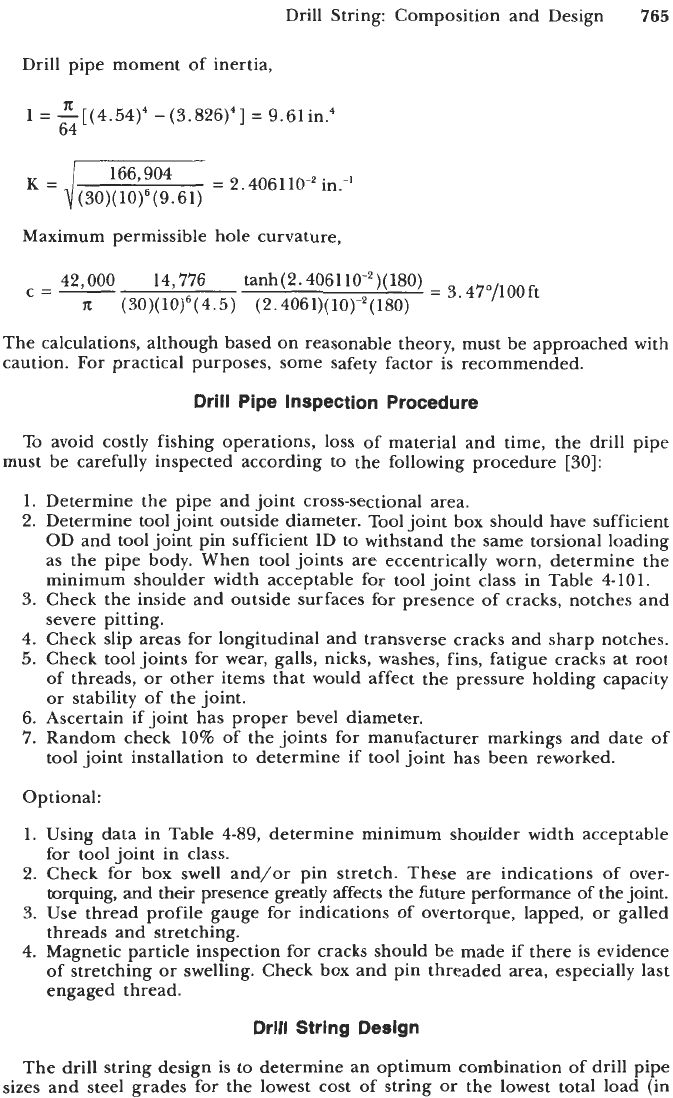
Drill String: Composition and Design
765
Drill pipe moment of inertia,
n
I
=
-[(4.54)4 -(3.826)4]
=
9.61in.4
64
Maximum permissible hole curvature,
42,000 14,776
tanh
(2.4061
lo-*
)(
180)
=
3.
47 o,l
oo
ft
c=-
z
(30)(
(
4.5) (2.4061)(
lo)-'
(
180)
The calculations, although based on reasonable theory, must be approached with
caution. For practical purposes, some safety factor is recommended.
Drill Pipe Inspection Procedure
To avoid costly fishing operations, loss of material and time, the drill pipe
must be carefully inspected according to the following procedure
[30]:
1.
Determine the pipe and joint cross-sectional area.
2.
Determine tool joint outside diameter. Tool joint box should have sufficient
OD and tool joint pin sufficient ID to withstand the same torsional loading
as the pipe body. When tool joints are eccentrically worn, determine the
minimum shoulder width acceptable for tool joint class in Table
4-101.
3.
Check the inside and outside surfaces for presence of cracks, notches and
severe pitting.
4.
Check slip areas for longitudinal and transverse cracks and sharp notches.
5.
Check tool joints for wear, galls, nicks, washes, fins, fatigue cracks at root
of threads, or other items that would affect the pressure holding capacity
or stability of the joint.
6.
Ascertain if joint has proper bevel diameter.
7.
Random check
10%
of the joints for manufacturer markings and date of
tool joint installation to determine
if
tool joint has been reworked.
Optional:
1.
Using data in Table
4-89,
determine minimum shoulder width acceptable
for tool joint in class.
2.
Check for box swell and/or pin stretch. These are indications of over-
torquing, and their presence greatly affects the future performance of the joint.
3.
Use thread profile gauge for indications of overtorque, lapped, or galled
threads and stretching.
4.
Magnetic particle inspection for cracks should be made if there is evidence
of stretching or swelling. Check box and pin threaded area, especially last
engaged thread.
Drill String Design
The drill string design is to determine an optimum combination of drill pipe
sizes and steel grades for the lowest cost of string or the lowest total load (in

766
Drilling and Well Completions
very deep drilling) that has sufficient strength to successfully accomplish
expected goals. Having in mind that the drill string is subjected to many loads
that may exist as static loads, cycling loads and dynamic loads, the problem of
drill string design is complex. Due to the complexity of the problems, some
simplifications are always made and, therefore, several decisions are left up to
the person responsible for the design.
In general, a reasonably bad working condition should be assumed and, for
that reason, a good knowledge of expected problems much as hole drag,
torquing, risk of becoming stuck, tendency to drill a crooked hole, vibrations,
etc., is
of
critical importance.
The person responsible for the design must know drill string performance
properties, data from wells already drilled in the nearest vicinity and current
prices of the drill string elements.
The designer should simultaneously consider the following main conditions:
1.
The working load at any part of the string must be less or equal to the
load capacity of the drill string member under consideration divided by
the safety factor.
2.
Ratio of section moduli of individual string members should be less
than
5.5.
3.
To
minimize pressure losses, the ratio of drill pipe outside diameter
to
borehole diameter, whenever possible, should be about
0.6.
Normally, based on hole diameter, the designer can select drill collar diameter
and drill pipe diameter. Next, specific pipe is chosen; the maximum length of
that pipe must be determined based on condition
1.
For this purpose, the
following equation is used:
(4-71)
where Ldc
=
length of drill collar string in ft
Wdp
=
unit weight of drill collar in air in Ib/ft
Lhw
=
length
of
heavyweight drill pipe (if used in the string) in ft
Whw
=
unit weight of heavy-weight drill pipe in lb/ft
Ldp,
=
length of drill pipe under consideration above the heavy-weight drill
Wdp,
=
unit weight of drill pipe (section
1)
in lb/ft
pipe in ft
K,
=
buoyant factor
PI
=
tension load capacity of drill pipe (section 1) in lb
SF
=
safety factor
Solving Equation
4-71
for Ldp, yields
(4-72)
If the sum of
Ldc
+
Lhw
+
Ldp, is less than the planned borehole depth, the
stronger pipe must be selected or a heavier pipe must be used in the upper
part
of
the hole.
The maximum length of the upper part in a tapered string may be calculated
from Equation
4-73:
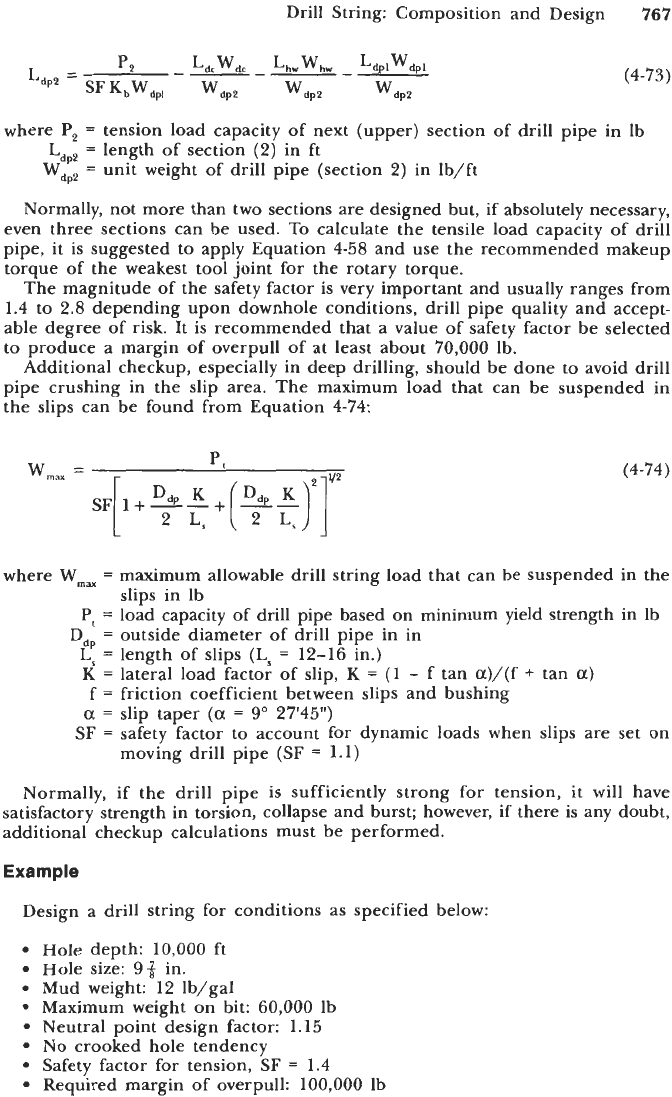
Drill String: Composition and Design
767
(4-73)
where
P,
=
tension load capacity of next (upper) section of drill pipe in lb
Ldp2
=
length of section
(2)
in ft
Wdpz
=
unit weight of drill pipe (section
2)
in lb/ft
Normally, not more than two sections are designed but, if absolutely necessary,
even three sections can be used. To calculate the tensile load capacity of drill
pipe,
it
is
suggested to apply Equation
4-58
and use the recommended makeup
torque of the weakest tool joint for the rotary torque.
The magnitude of the safety factor is very important and usually ranges from
1.4
to
2.8
depending upon downhole conditions, drill pipe quality and accept-
able degree of risk. It is recommended that a value of safety factor be selected
to
produce a margin of overpull of at least about
70,000
lb.
Additional checkup, especially in deep drilling, should be done to avoid drill
pipe crushing in the slip area. The maximum load that can be suspended in
the slips can be found from Equation
4-74:
D
(4-74)
where
W,=
=
maximum allowable drill string load that can be suspended in the
slips in lb
Pt
=
load capacity of drill pipe based on minimum yield strength in lb
Ls
=
length of slips
(Ls
=
12-16 in.)
K
=
lateral load factor of slip,
K
=
(1
-
f
tan
a)/(f
+
tan
a)
f
=
friction coefficient between slips and bushing
a
=
slip taper
(a
=
9"
27'45")
Ddp
=
outside diameter of drill pipe in in
SF
=
safety factor to account for dynamic loads when slips are set on
moving drill pipe
(SF
=
1.1)
Normally, if the drill pipe is sufficiently strong
for
tension, it will have
satisfactory strength in torsion, collapse and burst; however, if there is any doubt,
additional checkup calculations must be performed.
Example
Design a drill string for conditions as specified below:
Hole depth:
10,000
ft
Hole size:
93
in.
Mud weight: 12 lb/gal
Maximum weight on bit:
60,000
Ib
Neutral point design factor:
1.15
No crooked hole tendency
Safety factor for tension,
SF
=
1.4
Required margin
of
overpull:
100,000
lb
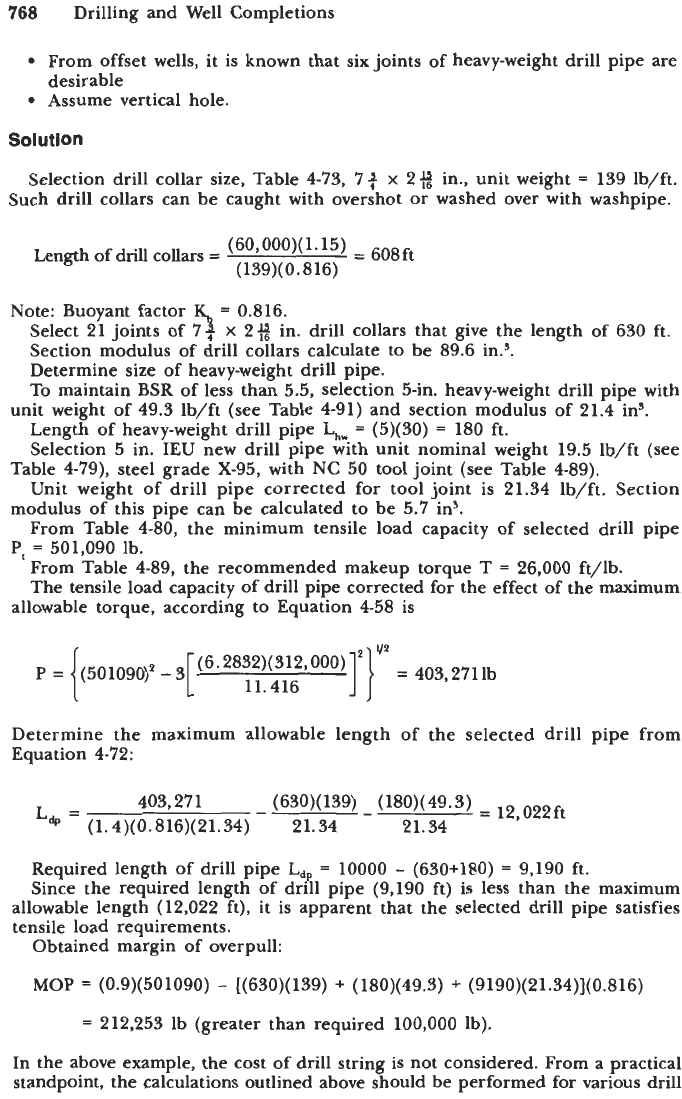
768
Drilling and Well Completions
From offset wells, it is known that six joints of heavy-weight drill pipe are
Assume vertical hole.
desirable
Solution
Selection drill collar size, Table
4-73,
7q
x
2%
in., unit weight
=
139
lb/ft.
Such drill collars can be caught with overshot
or
washed
over
with washpipe.
(60,000)(1’15)
=
608ft
Length of drill collars
=
(139)( 0.816)
Note: Buoyant factor
=
0.816.
Select
21
joints of
2
x
2#
in. drill collars that give the length
of
630
ft.
Section modulus of drill collars calculate
to
be
89.6
in.3.
Determine size of heavy-weight drill pipe.
To maintain BSR of less than
5.5,
selection 5-in. heavy-weight drill pipe with
Length of heavy-weight drill pipe
hw
=
(5)(30)
=
180
ft.
Selection
5
in. IEU new drill pipe with unit nominal weight
19.5
lb/ft (see
Unit weight of drill pipe corrected for tool joint is
21.34
lb/ft. Section
From
Table
4-80,
the minimum tensile load capacity of selected drill pipe
From Table
4-89,
the recommended makeup torque T
=
26,000
ft/lb.
The tensile load capacity of drill pipe corrected for the effect of the maximum
unit weight of
49.3
lb/ft (see Table
491)
and section modulus of
21.4
in3.
Table
4-79),
steel grade
X-95,
with
NC
50
tool joint (see Table
4-89).
modulus of this pipe can be calculated to be
5.7
in3.
PI
=
501,090
lb.
allowable torque, according
to
Equation
458
is
Determine the maximum allowable length of the selected drill pipe from
Equation
4-72:
L,
=
403,271
-
(630)(139)
-
(180)(49.3)
=
12,022ft
(1.4)(0.816)(21.34) 21.34 21.34
Required length of drill pipe L,,.p
=
10000
-
(630+180)
=
9,190
ft.
Since the required length of drill pipe
(9,190
ft) is less than the maximum
allowable length
(12,022
ft), it is apparent that the selected drill pipe satisfies
tensile load requirements.
Obtained margin of overpull:
MOP
=
(0.9)(501090)
-
[(630)( 139)
+
(180)(49.3)
+
(9190)(21.34)](0.816)
=
212,253
lb (greater than required
100,000
lb).
In the above example, the cost
of
drill string is not considered. From a practical
standpoint, the calculations outlined above should be performed for various drill
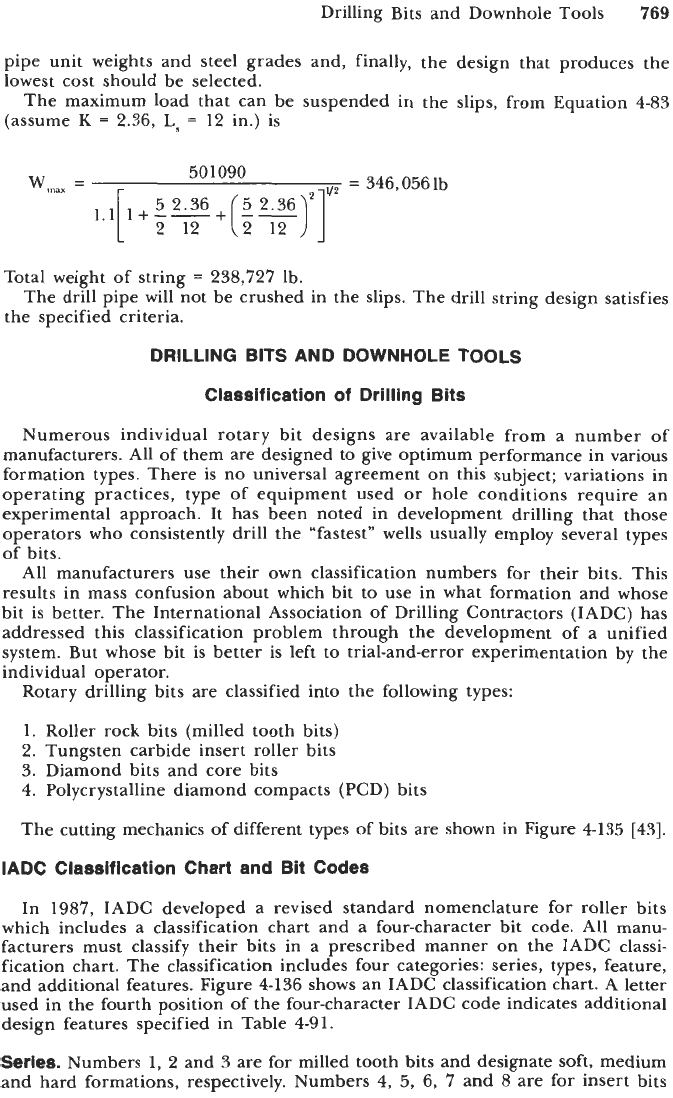
Drilling Bits and Downhole Tools
769
pipe unit weights and steel grades and, finally, the design that produces the
lowest cost should be selected.
The maximum load that can be suspended in the slips, from Equation
4-83
(assume
K
=
2.36,
Ls
=
12
in.) is
v2
=
346,056
lb
501090
wmm
=
Total weight of string
=
238,727
Ib.
the specified criteria.
The drill pipe will not be crushed in the slips. The drill string design satisfies
DRILLING BITS AND DOWNHOLE TOOLS
Classification of Drilling Bits
Numerous individual rotary bit designs are available from a number of
manufacturers. All of them are designed to give optimum performance in various
formation types. There
is
no universal agreement on this subject; variations in
operating practices, type of equipment used or hole conditions require an
experimental approach. It has been noted in development drilling that those
operators who consistently drill the “fastest” wells usually employ several types
of bits.
All manufacturers use their own classification numbers for their bits. This
results in mass confusion about which bit to use in what formation and whose
bit is better. The International Association of Drilling Contractors (IADC) has
addressed this classification problem through the development of a unified
system. But whose bit is better is left to trial-and-error experimentation by the
individual operator.
Rotary drilling bits are classified into the following types:
1.
Roller rock bits (milled tooth bits)
2.
Tungsten carbide insert roller bits
3.
Diamond bits and core bits
4.
Polycrystalline diamond compacts (PCD) bits
The cutting mechanics of different types of bits are shown in Figure
4-135 [43].
IADC Classification Chart and Bit Codes
In
1987,
IADC developed a revised standard nomenclature for roller bits
which
includes a classification chart and a four-character bit code. All manu-
facturers must classify their bits in a prescribed manner on the IADC classi-
fication chart. The classification includes four categories: series, types, feature,
and additional features. Figure
4-136
shows an IADC classification chart. A letter
used in the fourth position of the four-character IADC code indicates additional
design features specified in Table
4-91.
Series.
Numbers
1,
2
and
3
are for milled tooth bits and designate soft, medium
and hard formations, respectively. Numbers
4,
5,
6,
7
and
8
are for insert bits
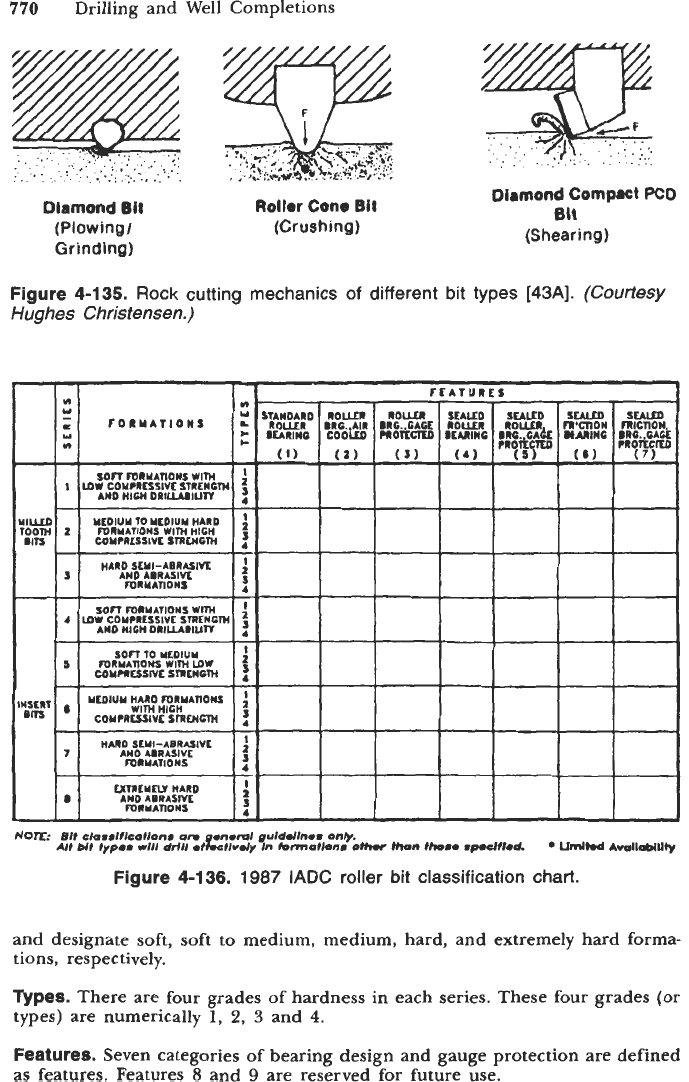
770
Drilling and Well Completions
.
,
.
:_
.
.
..
.
Dbmond
811
(Plowing
I
Grinding)
Oirmond
Compact
PCD
Bit
(Shearing
1
Roller
Cone
Bit
(Crushing)
Figure 4-135.
Rock
cutting mechanics
of
different bit types
[43A].
(Courtesy
Hughes
Christensen.)
Figure 4-1
36.
1987
IADC
roller
bit
classification
chart.
and designate soft, soft to medium, medium, hard, and extremely hard forma-
tions, respectively.
Types.
There are four grades
of
hardness in each series. These four grades
(or
types)
are
numerically
1,
2,
3
and
4.
Features.
Seven categories of bearing design and gauge protection are defined
as features. Features
8
and
9
are reserved
for
future use.
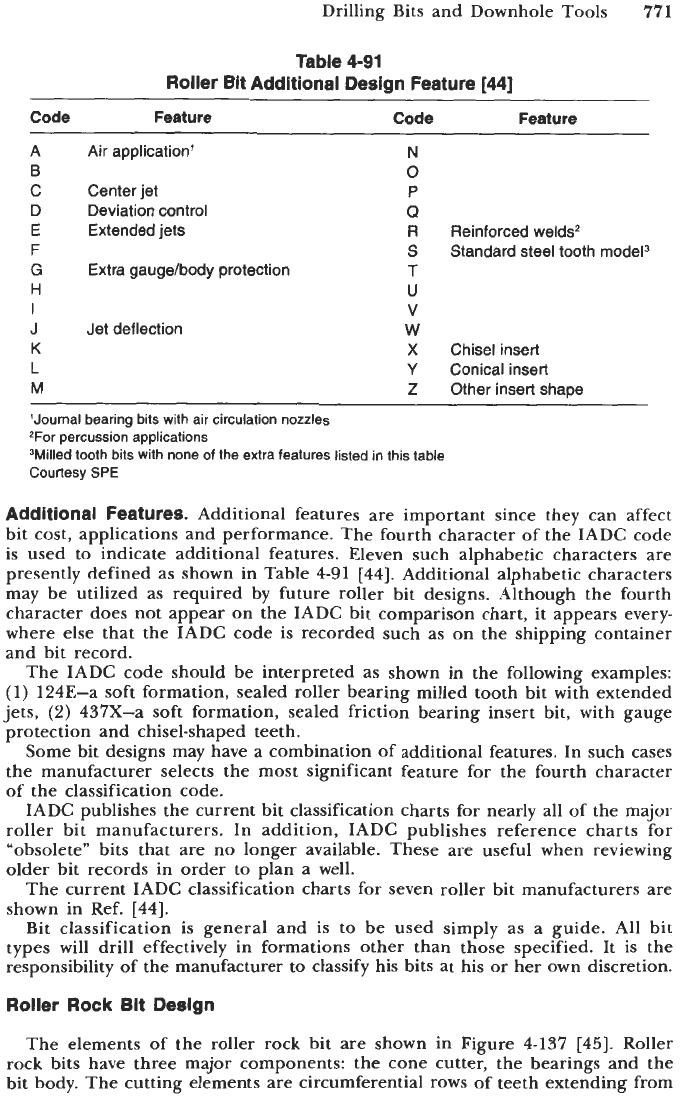
Drilling Bits and Downhole Tools
771
Table
4-91
Roller Bit Additional Design Feature
[44]
Code Feature Code Feature
~ ~~ ~~ ~ ~ ~ ~ ~~ ~~~~
A Air application'
N
B
0
C Centerjet
P
D Deviation control
Q
E
Extended jets
R
Reinforced welds2
F
S
Standard steel tooth model3
H
U
I
V
J
Jet deflection
W
K
X
Chisel insert
L
Y
Conical insert
M
Z
Other insert shape
'Journal bearing bits with air circulation nozzles
2For percussion applications
3Milled tooth bits with none of the extra features listed in this table
Courtesy
SPE
G
Extra gaugebody protection
T
Additional Features.
Additional features are important since they can affect
bit cost, applications and performance. The fourth character of the IADC code
is used to indicate additional features. Eleven such alphabetic characters are
presently defined as shown in Table 4-91 [44]. Additional alphabetic characters
may be utilized as required by future roller bit designs. Although the fourth
character does not appear on the IADC bit comparison chart, it appears every-
where else that the IADC code is recorded such as on the shipping container
and bit record.
The IADC code should be interpreted as shown in the following examples:
(1)
124E-a soft formation, sealed roller bearing milled tooth bit with extended
jets,
(2)
437X-a soft formation, sealed friction bearing insert bit, with gauge
protection and chisel-shaped teeth.
Some bit designs may have a combination of additional features. In such cases
the manufacturer selects the most significant feature for the fourth character
of the classification code.
IADC publishes the current bit classification charts for nearly all of the major
roller bit manufacturers. In addition, IADC publishes reference charts for
"obsolete" bits that are no longer available. These are useful when reviewing
older bit records in order to plan a well.
The current IADC classification charts for seven roller bit manufacturers are
shown in Ref. [44].
Bit classification is general and is
to
be used simply as a guide. All bit
types will drill effectively in formations other than those specified. It is the
responsibility of the manufacturer to classify his bits at his or her own discretion.
Roller
Rock
Bit Design
The elements of the roller rock bit are shown in Figure 4-137 [45]. Roller
rock bits have three major components: the cone cutter, the bearings and the
bit body. The cutting elements are circumferential rows of teeth extending from
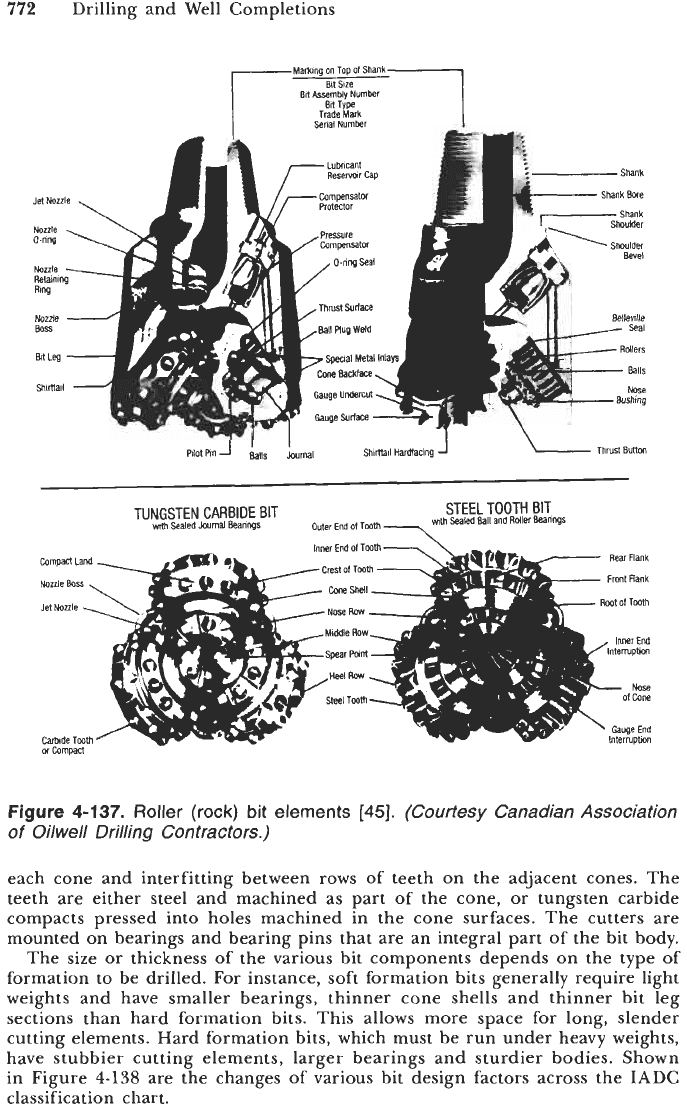
772
Drilling and Well Completions
STEEL TOOTH BIT
TUNGSTEN CARBIDE BIT
wim
Sealed Journal BeanngS
wilh
Sealed
Ball
and Roller Bearings
Outer End
of
Twm
-
Figure
4-137.
Roller (rock)
bit
elements
[45].
(Courtesy
Canadian Association
of
Oilwell Drilling Contractors.)
each cone and interfitting between rows of teeth on the adjacent cones. The
teeth are either steel and machined as part of the cone, or tungsten carbide
compacts pressed into holes machined in the cone surfaces. The cutters are
mounted on bearings and bearing pins that are an integral part of the bit body.
The size or thickness of the various bit components depends on the type of
formation to be drilled. For instance, soft formation bits generally require light
weights and have smaller bearings, thinner cone shells and thinner bit leg
sections than hard formation bits. This allows more space for long, slender
cutting elements. Hard formation bits, which must be run under heavy weights,
have stubbier cutting elements, larger bearings and sturdier bodies. Shown
in Figure
4-138
are the changes of various bit design factors across the IADC
classification chart.
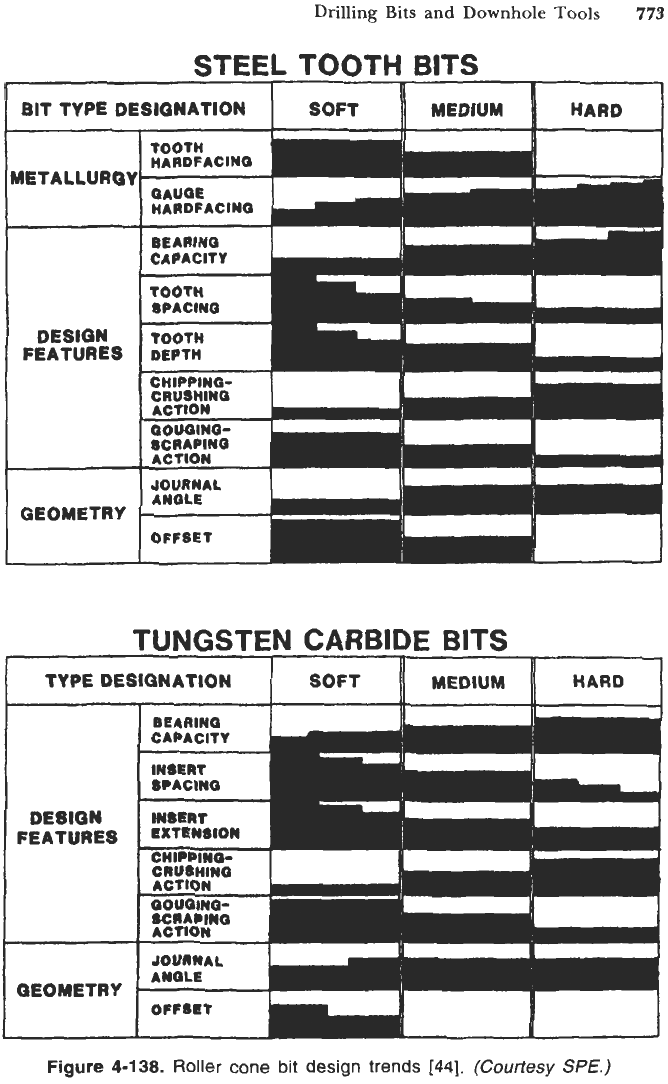
Drilling
Bits
and
Downhole
Tools
773
STEEL TOOTH
BITS
BIT
TYPE
DESIGNATION SOFT MEDIUM HARD
1
METALLURQY
DESi6N
FEATURES
GEOMETRY
TUNGSTEN
CARBIDE
BITS
TYPE
DESIQNATION
SOFT
MEDIUM
HARD
OFFItT
I
Figure
4-138.
Roller
cone bit design trends
[44].
(Courtesy
SPE.)
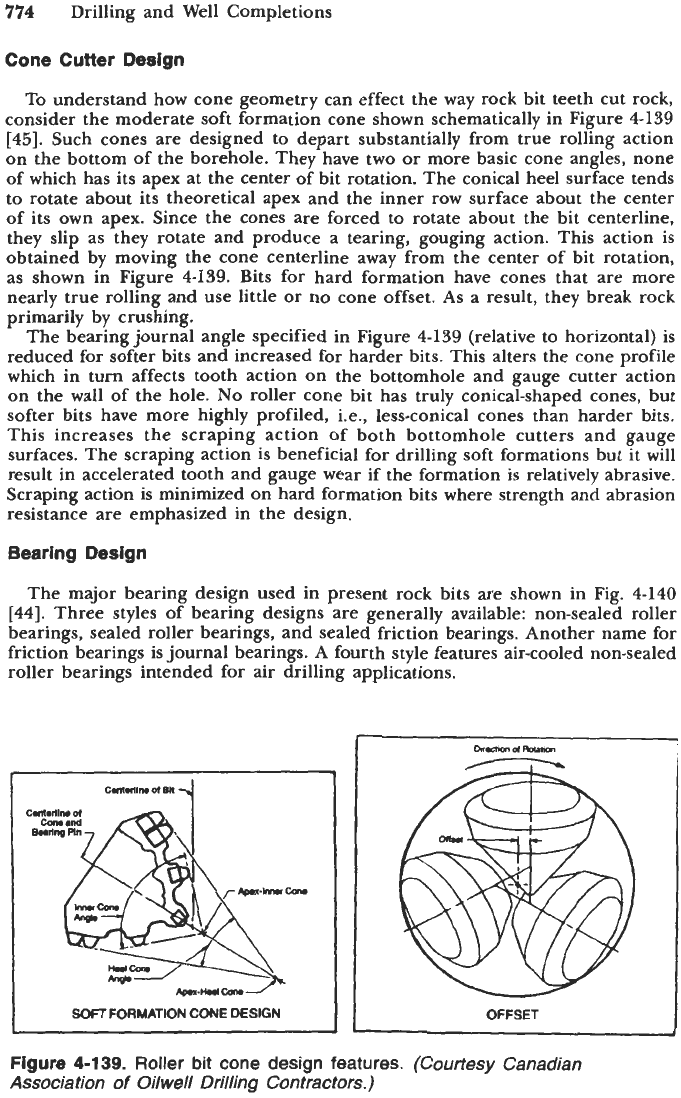
774
Drilling and Well Completions
Cone Cutter Design
To
understand how cone geometry can effect the way rock bit teeth cut rock,
consider the moderate soft formation cone shown schematically in Figure
4-159
[45].
Such cones are designed to depart substantially from true rolling action
on the bottom of the borehole. They have two
or
more basic cone angles, none
of which has its apex at the center of bit rotation. The conical heel surface tends
to rotate about its theoretical apex and the inner row surface about the center
of its own apex. Since the cones are forced to rotate about the bit centerline,
they slip as they rotate and produce a tearing, gouging action. This action is
obtained by moving the cone centerline away from the center of bit rotation,
as shown in Figure
4-139.
Bits for hard formation have cones that are more
nearly true rolling and use little
or
no cone offset.
As
a result, they break rock
primarily by crushing.
The
bearing journal angle specified in Figure
4-139
(relative to horizontal) is
reduced for softer bits and increased for harder bits. This alters the cone profile
which in turn affects tooth action on the bottomhole and gauge cutter action
on the wall of the hole.
No
roller cone bit has truly conical-shaped cones, but
softer bits have more highly profiled, i.e., less-conical cones than harder bits.
This increases the scraping action of both bottomhole cutters and gauge
surfaces. The scraping action is beneficial for drilling soft formations but it
will
result in accelerated tooth and gauge wear if the formation is relatively abrasive.
Scraping action is minimized on hard formation bits where strength and abrasion
resistance are emphasized in the design.
Bearing Design
The major bearing design used in present rock bits
are
shown in Fig.
4-140
[44].
Three styles of bearing designs
are
generally available: non-sealed roller
bearings, sealed roller bearings, and sealed friction bearings. Another name for
friction bearings is journal bearings.
A
fourth style features air-cooled non-sealed
roller bearings intended for air drilling applications.
Apw4m#lcar-.
SOFT
FORMATION
CONE
DESIGN
CWW3bno(k&lom
OFFSET
Figure
4-139.
Roller
bit
cone design
features.
(Courtesy Canadian
Association
of
Oilwell
Drilling Contractors.)
